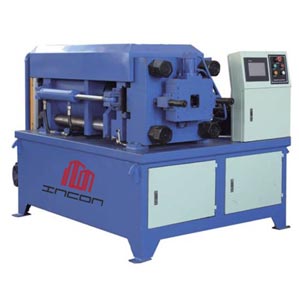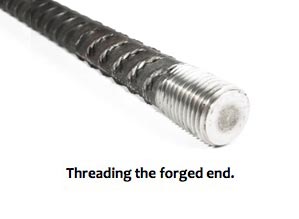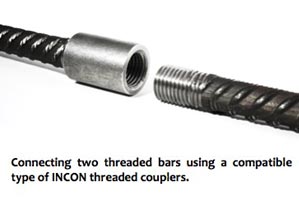Forged Threaded Couplers
Forged Threaded Couplers Categories
ITS – Standard Coupler
ITS Coupler is used when at least one of the bars is free to rotate about its axis. It consists of an internally threaded steel tube that accommodates two threaded bars of matching exterior threads. This feature allows the connections to be assembled in situations that do not involve significant construction constraints.
ITP – Position Coupler
ITP Coupler is used when the bars to be connected are restrained against rotational movement and at least one of them is allowed to move along its longitudinal axis. This coupler is recommended when there are no constraints that prevent both bars from approaching the coupler without the need for a tolerance.
ITPL – Position Coupler with Tolerance
ITPL Coupler is similar to ITP Coupler but extends over a longer distance to allow for a tolerance between the two bars. This feature allows the mechanical connections to be assembled in situations where two steel cages are to be connected simultaneously or at least one of the bars is bent or curved.
ITR – Position Coupler with Rod
ITR Coupler possesses the same features as the ITP Coupler but provides more flexibility to connect the reinforcement in RC members cast at different times. The coupler is composed of two internally threaded tubes, a threaded rod and a lock nut that connect two steel bars of matching thread size.
ITST – Transition Coupler
ITST Coupler functions in a similar manner to the ITS Coupler but is used when the bars to be connected have different diameters. This feature allows the mechanical connections to be assembled in locations that experience abrupt variation in bars’ sizes especially at beam-column, and column-column connections.
ITRT – Position Transition Coupler with Rod
ITRT Coupler possesses the same features of the ITP Coupler but is used when the bars to be connected are of different sizes. The threads inside the extended coupler sleeve are uniform along its profile and are matching those on the smaller bar and threaded rod. The shorter coupler sleeve acts as a transition coupler that connects bars of larger diameter to the threaded rod. The lock nut is used to secure the connection.
INCON ADVANCED THREADING TECHNOLOGY
Conventional threading of reinforcing bars will result in a relatively significant reduction in their nominal cross-sectional area by approximately 15% to 25% depending on the thread size. This will result in a considerable drop in the splice strength that has to be accounted for. To overcome this issue, INCON has developed its innovative fabrication machine that combines both cold forging and parallel threading technologies of the reinforcing bars’ ends. Upsetting the threaded ends of the bars enlarges the cross-sectional area at those locations in order to compensate for the area reduction associated with threading. In this manner, ultimate capacity of the connection is achieved by yielding of the reinforcing bar away from the splicing zone. Thus, full capacity of the reinforcing bars is completely attained. Our advanced forging and threading process can be performed on all bar sizes available in the market including 10M through 55M (Canada), #4 through #18 (US), and 12 through 50 (Europe and Middle East)..
CHARACTERISTICS OF INCON’S THREADING MACHINE
ASSEMBLING FORGED THREADED CONNECTIONS
FORGING
Each reinforcing bar is inserted into a hydraulically actuated bench press that enlarges its end by a cold-forging operation.
THREADING
After that, threads are formed on the upsized section of the bar depending on the bar diameter and the splice length.
WHY INCON’S THREADED COUPLERS?
INCON threaded couplers integrate durability; structural performance and cost effectiveness to provide our valuable clients with state-of-the-art products and services that satisfy all their needs.
STRUCTURAL PERFORMANCE
- Full strength of the reinforcing bars is maintained.
- Reduction in cross-sectional area due to conventional threading is eliminated.
- Ductile behavior in the structural members is maintained.
- Structural performance is independent of concrete type and strength.
- Slip is completely eliminated between couplers and the embedded steel bars.
- Bars are concentrically aligned resulting in direct force transfer between the two bars.
- Eliminate potential slip, hook straightening or side spalling that may occur in conventional hooked or bent bars.
CONSTRUCTION SIMPLICITY
- Screwing the coupler onto the threaded bars without the need of a torque wrench.
- INCON automatic upsetting and threading machine simplifies the forging and threading of the reinforcing bars’ heads.
- Formation of construction joints is greatly simplified.
- Congestion of steel reinforcement is significantly reduced.
- Formwork damage is avoided during construction of wall-slab connections.
- Substantial reduction in the number of laborers needed for cut and bend works.
COST EFFECTIVENESS
- Remarkable saving in material and labor cost.
- Savings in steel cost and welding material, especially for long splices.
- Eliminating formwork cutting and drilling makes it possible to reuse it multiple times in construction.
- Reduction in time required for preparing detailed drawings and detailed calculation sheets for lap splices and bent bars during the design phase.
- Reduction in inspection time for lap splices and bent bars during the construction phase.
QUALITY CONTROL
- INCON couplers and bar terminators are manufactured in accordance with the strictest Canadian standards in ISO certified and UKAS accredited facilities.
- Both experimental and analytical investigations are performed on our products to ensure outstanding structural performance that exceeds the requirements provided in building codes and standards.
- In addition to our research and development program, INCON has been working in collaboration with Western University in Canada to continuously develop the quality of our mechanical splicing devices.
ENVIRONMENT
- INCON mechanical couplers are recyclable and may be manufactured of recycled materials.
- Reinforcement waste associated with lap splices and bent bars is significantly reduced.
- No welding; or heating required in production process or site applications.













